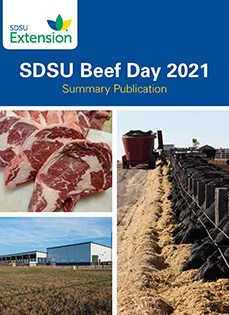
SDSU Beef Day 2021 Summary Publication
Document Type
Article
Publication Date
1-21-2021
Abstract
Objective
The objective was to evaluate the impact of nutritional changes post artificial insemination (AI) on plasma metabolites, steroid hormones, and uterine environment.
Study Description
Beef heifers (n = 43) were randomly assigned to two dietary treatment groups (High = 161.5% or Low = 77.5% of maintenance energy) for 14 d after AI (post-AI). Post-AI dietary treatments continued until uteri were flushed for embryo recovery (d 14 post-AI). Blood samples were collected on d -3, 0 (day of AI), 3, 6, 9, 12, and 14 for analysis of plasma glucose, proteins, non-esterified fatty acids (NEFAs), and cholesterol using colorimetric assays. Plasma collected on d 0, 3, 6, 9, 12, and 14 was analyzed for progesterone concentrations by radioimmunoassay. Uterine flushes were analyzed for mineral concentrations of Mg, P, S, K, Ca, Cu, Zn, Se, Mn, Co, B, Cr, and Fe by Inductively Coupled Plasma Mass Spectrometry (ICP-MS). Plasma progesterone, NEFAs, protein, glucose and cholesterol (repeated measures) and uterine mineral concentrations were analyzed using the MIXED procedures in SAS. Plasma NEFA concentrations differed between treatments (P = 0.03) with heifers on the low diet treatment having elevated NEFA concentrations. Plasma NEFA concentrations weren’t affected by embryo recovery (P > 0.10), treatment by embryo recovery (P > 0.10), and treatment by embryo recovery by day (P > 0.10). Plasma progesterone, glucose, protein, and cholesterol concentrations were not influenced by treatment (P > 0.10), embryo recovery (P > 0.10), treatment by embryo recovery (P > 0.10), and treatment by embryo recovery by day (P > 0.10). Uterine mineral concentrations were affected by embryo presence for Mg (P = 0.02) and S (P = 0.01) a tendency for Ca (P = 0.08) with decreased concentrations in uterine flushes when an embryo was recovered. A tendency for increased concentration of Mn (P = 0.06) was observed in uterine flushes when an embryo was recovered. Additionally, treatment tended to impact Fe concentrations (P = 0.09), with heifers on the restricted diet having reduced uterine Fe concentrations. In conclusion, changing plane of nutrition post-AI had an effect on NEFA plasma concentrations, but no effect on plasma progesterone, protein, glucose, and cholesterol concentrations. The presence of an embryo however affected uterine mineral concentrations.
Pages
7
Publisher
South Dakota State University
Rights
© 2021 South Dakota Board of Regents
Recommended Citation
Andrews, Taylor N.; Epperson, Kaitlin M.; Rich, Jerica J.J.; Zoca, Saulo Menegatti; Kline, Adalaide C.; Quail, Lacey K.; Zezeski, Abigail L.; Geary, Thomas W.; Walker, Julie A.; and Perry, George A., "Interactions of Change in Nutrition After AI on Plasma Metabolites, Steroid Hormone Production, and Uterine Environment" (2021). SDSU Beef Day 2021 Summary Publication. 11.
https://openprairie.sdstate.edu/sd_beefday_2021/11
